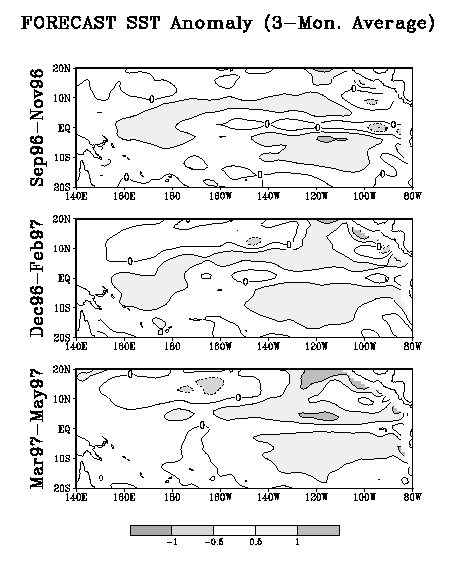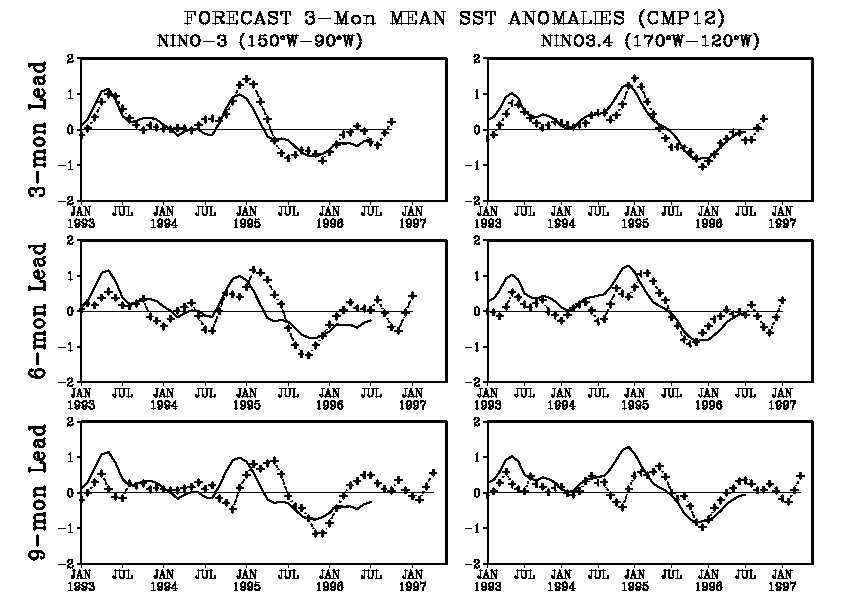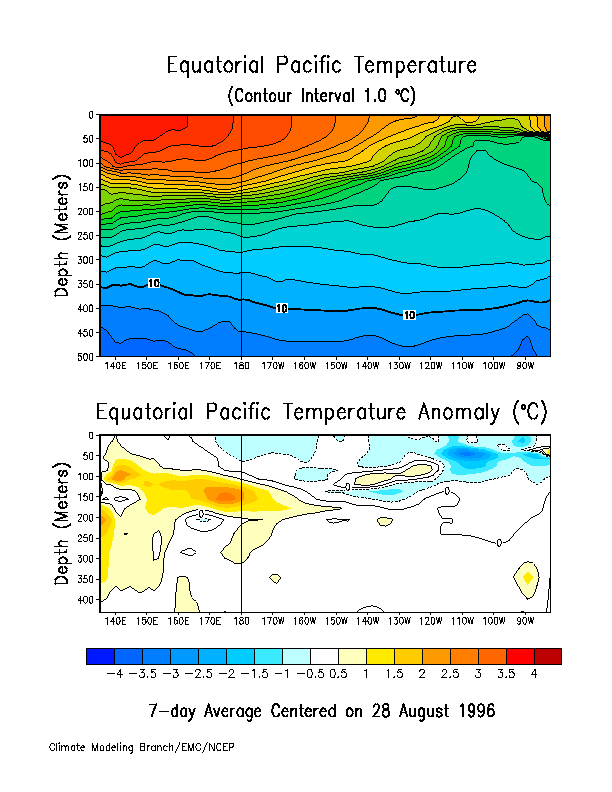
contributed by Ming Ji, Arun Kumar and Ants Leetmaa
National Centers for Environmental Prediction, NOAA, Camp
Springs, Maryland
A non-simple coupled ocean-atmosphere model has been developed for
use for long-lead climate forecasts in the Coupled Model Project at NOAA's
National Centers for Environmental Prediction (NCEP) (Ji et al. 1994a,b).
The NCEP Medium Range Forecast (MRF) atmospheric model is used with a dynamic
Pacific Basin ocean model originated at the Geophysical Fluid Dynamics
Laboratory. The MRF has a reduced spatial resolution and is tuned for more
realistic tropical circulation. The ocean thermal field, including SST
and subsurface temperature, is initialized using an ocean data assimilation
system (Ji et al. 1995). Research has shown that when observed SST fields
are prescribed, this coupled model's atmospheric response is fairly reliable
in the tropics but considerably less so in the extratropics. The extratropical
response is best during the warm or cold phase of ENSO as reflected in
the SST. Much attention has in fact been given to the prediction of ENSO
itself--the tropical Pacific SST anomaly. Such a forecast is presented
here.
In the September and December 1993 issues of this Bulletin, the expected
forecast skill of the coupled model version used in 1993 (called CMP6)
was shown. A horseshoe-shaped spatial pattern of maximum model skill was
noted, with highest equatorial skill near the date line and higher skill
just north or south of the equator than immediately along it to the east
of 165oW. The model generally outperformed persistence by a
substantial margin in forecasting the Niño 3 and Niño 4 regions.
A seasonal dependence in skill was noted, where forecasts were affected
by a "spring barrier" as found both in other dynamical as well
as statistical predictive models.
Starting with the forecasts presented in the September 1994 issue,
the NCEP coupled model was upgraded with a refinement of the flux climatology
and the installation of a MOS correction for the stress anomalies produced
by the atmospheric model. Skills consequently improved as the high skill
area extended farther eastward into the western part of the Niño
3 region. Figures 2-1 and 2-2 of the September 1994 issue show a comparison
of hindcast skills between the improved (CMP9) and the previous model versions
as a function of lead time for Niño 3 and Niño 4.
In spring 1995, another improvement was implemented, resulting in
the CMP10 version (Ji et al. 1996). While CMP9 contained a negative feedback
procedure for coupling the anomalous net heat flux, CMP10 used anomaly
coupling for the net heat flux forcing. Mean skills were not as different
between CMP9 and CMP10 as they were for CMP6 and CMP9; however, CMP10 behaved
more realistically for high amplitude SST anomalies. CMP9, with its negative
feedback mechanism, ran the danger of damping strong ENSO events too much
and/or too soon.
The most recent improvement of the NCEP coupled model was completed
during summer 1996, and is used in the forecasts presented here. This current
version, called CMP12, has the highest hindcast skills in the model's history
over the central and eastern equatorial Pacific over for 1981-95 exceeding
0.8 correlation skill in much of that area for 4-6 month lead hindcasts.
Upgrades in CMP12 include improvements in the data assimilation system,
as well as model improvements such as better mixing in the ocean model
and more representative anomalous e-p (evaporation-precipitation) flux
forcing in the coupling. CMP12 forecasts out to 6 months lead are now updated
on a weekly basis and are available on Internet site http://nic/fb4.noaa.gov:8000/research/climate/html.
The forecasts are ensemble averages of 9 individual runs, each using different
initial atmospheric conditions based on 1-day-apart transient atmospheric
states resulting from integrations using 1-day-old start times successively
staggered by 1 day (i.e., each dependent on the previous outcome, and the
first dependent on a 15-day-old start time).
The CMP12 coupled model forecasts for the SST anomaly field averaged
over Sep-Oct-Nov 1996 (no lead), Dec-Jan-Feb 1996-97 (3 months lead) and
Mar-Apr-May 1997 (6 months lead) are shown in Fig. 1, where the systematic
model bias for hindcasts over the 1981-95 period has been subtracted. This
forecast is the mean of an ensemble of 9 individual cases as described
above. The forecast shows a tendency for warming between fall 1996 and
spring 1997, bringing the anomaly into mildly positive territory. The outlook
described by this forecast is warmer than that of the same CMP12 model
5 to 6 weeks ago (beginning of August), the time of the transition from
CMP10 when both the model versions were forecasting continuation of neutral
to somewhat cool conditions. Fig. 2 shows the Niño 3 and Niño
3.4 forecasts in the form of a time series for the three lead times used
to form the 3-month forecast averages used in Fig. 1. The upward-trending
SST forecast is clear.
The observed anomalous SST and subsurface equatorial temperature
field for the week centered on August 28 (Fig. 3) show negative subsurface
sea temperature anomalies in much of the eastern and east-central tropical
Pacific Basin. Positive subsurface anomalies appear in the western Pacific
and in the central Pacific at roughly 150 m. These warm sea temperatures
have not progressed eastward over the last 3 months, indicating a pause
in the anticipated transition to warm conditions farther east at the surface
over the coming year (Smith et al. 1995).
Ji, M., A. Kumar and A. Leetmaa, 1994a: A multi-season climate forecast
system at the National Meteorological Center. Bull. Am. Meteor. Soc.,
75, 569-577.
Ji, M., A. Kumar and A. Leetmaa, 1994b: An experimental coupled forecast
system at the National Meteorological Center: Some early results. Tellus,
46A, 398-418.
Ji, M., A. Leetmaa and J. Derber, 1995: An ocean analysis system for seasonal
to interannual climate studies. Mon. Wea. Rev., 123, 460-481.
Ji, M., A. Leetmaa and V.E. Kousky, 1996: Coupled model forecasts of ENSO
during the 1980s and 1990s at the National Meteorological Center. J.
Climate, 9, in press.
Smith, T.M., A. G. Barnston, M. Ji and M. Chelliah, 1995: The impact of
Pacific Ocean subsurface data on operational prediction of tropical Pacific
SST at the NCEP. Wea. Forecasting, 10, 708-714.

Fig. 1. NCEP (formerly NMC) coupled model SST anomaly forecast fields
for Sep-Oct-Nov 1996, Dec-Jan-Feb 1996-97, and Mar-Apr-May 1997. The CMP12
version of the model is used. Each forecast is an average of 9 individual
ensemble members, each based on a different one-day-apart initial atmospheric
condition (see text).

Fig. 2. NCEP coupled model SST anomaly forecast time series for Niño
3 and Niño 3.4 for Jul-Aug-Sep 1996 through Mar-Apr-May 1997 at
1-month increments. The broken line in each panel represents the SST anomaly
forecast (oC), and the solid line the observed SST anomaly.
Each forecast is an average of 9 individual ensemble members, each based
on a different one-day-apart initial atmospheric condition (see text).

Fig. 3. Equatorial depth-longitude section of ocean temperature anomaly
with respect to the 1983-92 mean for the week centered on August 28, 1996.